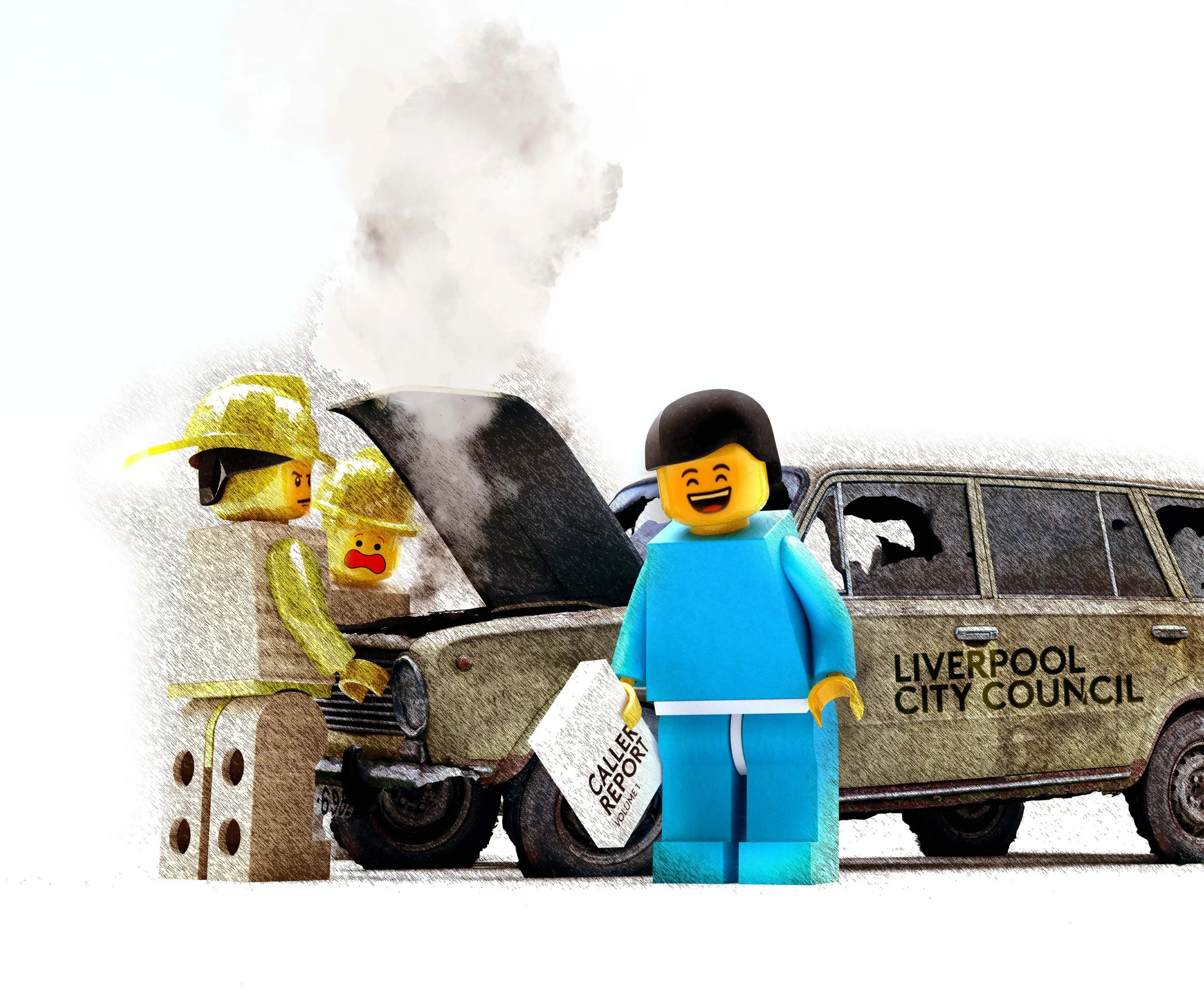Recent features
A new central Liverpool
As a youngster I’d often be dragged kicking and screaming into ‘town’ by my mother, first from Aigburth and later Speke on the 82 bus for a day traipsing around central Liverpool. The delights of these trips would include Solitaire, Dodo’s and Miss Selfridges (all high street names now consigned to the past) and we would start this bonanza at Lewis’ department store, jumping off the bus and into the throng of Saturday morning shoppers. We’d cut through Lewis’ giant store before heading to what was then the newly opened Clayton Square shopping centre and a supposedly refreshed green-glass clad St Johns Centre. From there the misery of shopping with your mum on a Saturday would commence.
Michael McDonough
As a youngster I’d often be dragged kicking and screaming into ‘town’ by my mother, first from Aigburth and later Speke on the 82 bus for a day traipsing around central Liverpool.
The delights of these trips would include Solitaire, Dodo’s and Miss Selfridges (all high street names now consigned to the past) and we would start this bonanza at Lewis’ department store, jumping off the bus and into the throng of Saturday morning shoppers. We’d cut through Lewis’ giant store before heading to what was then the newly opened Clayton Square shopping centre and a supposedly refreshed green-glass clad St Johns Centre. From there the misery of shopping with your mum on a Saturday would commence.
For me it was my first introduction to a big city centre alongside the odd jaunt over to Manchester and it was where I began to really think about architecture and the built environment. I’d see the different building styles and the variety of scale and begin to understand what fundamentally makes a city centre feel vibrant and appealing. Of course, today I’m a bit more travelled but I still think central Liverpool retains a bizarre and unique mix of architecture and energy that few European cities can rival.
Sadly today, Liverpool’s optimistic 1960’s shopping centre architecture and MDF pre-fab station retail (Liverpool Central) is all looking incredibly tired, like a patched up old car that’s had multiple uncaring owners. It still functions but it doesn’t look too good aesthetically.
Let’s take St Johns Centre, the largest indoor shopping centre in the city, squatting as it does right next to Liverpool’s front door to the world - Lime St. It’s also directly adjacent to some of the world’s finest neo-classical architecture such as St Georges Hall. This shopping behemoth, designed by architect James A. Roberts, landed ungraciously on the city in 1969 and has suffered two fires and several re-clads, leaving us with a mish mash of hasty spruce-up’s from owners who have lacked the deep pockets to do anything truly worthwhile.
The Centre itself was actually a much smarter affair when it first opened, before it was mauled by those who, in the 1990’s, thought faux-Victorian brick features would add a dash of sophistication. Still, in its defence St Johns remains very profitable for it’s owners, and this is likely the reason why it continues to squat on what should be a prime city centre site - a pound shop paradise instead of a Gucci-style emporium. It’s not all bad though, we were also gifted St Johns Beacon in 1969 as a glorified chimney to ventilate the centre. Better known today as the Radio City Tower, it’s become a landmark in itself, but also architectural marmite. Shorter than was originally intended, it’s short-lived rotating restaurant feature has long-since closed with its crown now defaced with radio antennae. Recently it was threatened with a quite frankly ridiculous zip wire proposal that would have seen the more adventurous amongst us flung across St Georges Hall before landing on top of the Liverpool Central Library, but thankfully, the subsequent uproar consigned the scheme to Liverpool City Council’s rather large book of planning mistakes.
St Johns Centre as viewed from St Georges Hall, 2020.
Clayton Square (left) and St Johns Centre (right), 2020.
St Johns is sadly not alone across this axis of tat that defaces central Liverpool. There is also the now, in my view, ruined Clayton Square. You might notice that I don’t refer to it as a ‘shopping centre’ because today it is a far cry from its intended design, having been boxed up internally for long standing retail anchor Boots the Chemist. The original grand and spacious feel of the 1990’s glass-covered mall lost behind MDF wall panels. The only redeeming feature of Clayton Square is its distinctive glass dome as a reminder of what once was. Again, the victim of a visionless ownership doing the bare minimum, this once impressive shopping centre has been turned into a forgettable cut-through.
Sadly today, Liverpool’s optimistic 1960’s shopping centre architecture and MDF pre-fab station retail (Liverpool Central) is all looking incredibly tired,…
The rap sheet of poor developments goes on…there’s the now wrecked former Blacklers store populated at ground level by the Wetherspoons pub chain and greasy low-end fast food joints. The unforgivebly bland and beige ION student accomodation scheme which replaced the Futurist (a building that still needed to go as it was collapsing). Its depressing cladded hulk hiding the even more depressing breeze block, creaking floor misery that is the Student ‘Castle’ behind. Then there’s the decaying former ABC art deco cinema on the opposite side of the road that has also fallen victim to numerous false dawns including plans to turn it into a TV studio. And who could forget the Holiday Inn towering above St Johns? For some bizarre reason, the hotel was painted black with white window frames and now provides a nice clean target for seagulls offloading their mess quite visibly across the facade, a delight I’m sure for those arriving at Lime St for the first time. But the pièce de resistance has to be the blue plastic cover stretching around the St Johns Centre car park as an apologetic gesture from the city leaders, who are all too aware of how much of an embarrassing eyesore this part of the city has become. No amount of repaving is going to fix that one.
I should stop there as the horrors of Williamson and Queens Squares with their out of town retail architecture are too much to bare. Even the entrance to Liverpool Central station and shopping centre is a sorry indictment of how quick the city is to demolish great architecture and replace it with worse. Too little is invested in Liverpool’s transport infrastructure today. If this was London, things would look very different.
Anyway, that’s enough of the critical; let’s move on to the constructive! At Liverpolitan, when it comes to architecture and urban design we at least like to have a stab at putting our money where our mouth is and so we’ve visualised what central Liverpool could potentially look like with a major, joined up and comprehensive redevelopment plan akin to Liverpool One.
The featured visuals explore how a forward-thinking city administration, alongside some ambitious local politicians and business leaders might take central Liverpool forward. The designs imagine a city centre unlocked from the obstructive mess that indoor shopping centres have created and moves instead to individual buildings and re-instated streets. Those buildings play host, not to the bargain basement, but to hotels, much needed Grade A flexible office and event spaces, small and medium-sized businesses. There’s also a leisure and media hub, landmark building to replace Clayton Square and ground-level, accessible market space to replace St Johns Market, now relocated to Williamson Square with the potential for it to spill out into the surrounding streets.
We imagine a new central Liverpool anchored by a new transport hub with a major expansion of Liverpool Central station returning this increasingly overcrowded and underinvested underground station in to something more in line with its former role as a national gateway with the completion of the Edge Hill Spur scheme to tunnel the Northern line out to Edge Hill and beyond (we’ll have an article on that at some point).
New and re-instated street connections between Queens Square and Central Station offer a clear line of sight through to the St Georges Hall portico. Rather than repeat the mistakes of St Johns, which for want of a better phrase, turned its architectural ‘arse’ to one of our grandest buildings, new structures will offer a proud face towards it. It’s almost as if architects in the 1960’s dismissed St Georges Hall as some imperialist soot-covered beast that would soon be demolished, and so contextually didn’t matter. Bulldozers were on the cards for Lime St’s Great Northwestern Hotel frontage, it it wasn’t for a campaign to stop them.
The design concepts envisage a far more porous central Liverpool with a new green space, elevated across several levels, looking out across St Georges Plateau. Hopefully it would act as an invitation to the now sad and disconnected lower London road to join the re-development party and come back into the city centre fold. Scale and world class architectural design would be the order of the day much like Liverpool One. Instead of leaving such an important project in the hands of a clique of local developers practice on a budget, International competitions would invite the world’s best to compete. Let the best designs and those with the best track records win out.
Lewis’, the former Blackers Store and the remaining streets between would all be spurred on to step-up and re-invent themselves. The result? A whole, new beating heart for central Liverpool, far more befitting of where the city wants and needs to be. A statement to anyone arriving at Lime St Station that Liverpool is a world class city that respects its heritage, but is determined to do everything it can to match and surpass its history. One that thinks bigger, and better.
It would be nice to get off the 82 bus one day and walk through a vibrant, modern central Liverpool - a place without chewing gum ridden pavements and hot dog stands. Liverpool One still set’s the bar for city centre regeneration. We did it before, we can do it again.
Michael McDonough is the Art Director and Co-Founder of Liverpolitan. He is also a lead creative specialising in 3D and animation, film and conceptual spatial design.
Share this article
What price heritage?
The UNESCO World Heritage Committee meets in China this July. One of the items on the agenda is going to be the recommendation to delete Liverpool – Maritime Mercantile City from the list of World Heritage Sites. If Liverpool is deleted from the list, it will be the only UK site ever to suffer this fate and only the second in Europe. There can be no doubt that the decision will be something that the city can do without at a time when it is struggling to emerge from the Covid pandemic and will, no doubt, attract far more attention in the national media than the original listing ever did. So, how have we got into this situation?
Martin Sloman
The UNESCO World Heritage Committee meets in China this July. One of the items on the agenda is going to be the recommendation to delete Liverpool – Maritime Mercantile City from the list of World Heritage Sites.
If Liverpool is deleted from the list, it will be the first UK site ever to suffer this fate and only the second in Europe. It’s a decision the city can could do without at a time when it’s struggling to emerge from the Covid pandemic. No doubt, the decision will attract far more attention in the national media than the original listing ever did. So, how have we got into this situation?
One thing is clear, UNESCO has a point. The inscription of the Liverpool site arose from an agreement to protect the Outstanding Universal Value (OUV) of the property. The development of Liverpool Waters was pursued outside of any planning framework agreed with UNESCO despite their repeated requests. The decision to develop a major football stadium on Bramley Moore Dock has brought matters to a head.
There is a wider issue though and that’s the value of World Heritage Status to a city such as Liverpool, which is always struggling to attract investment and jobs.
There are thirty-two WHS sites in the UK. Nearest to Liverpool are the Castles of Gwynedd, North Wales including those of Conwy, Caernarfon and Beaumaris, which boast some of the finest examples of medieval military defences in Europe. Even though their military function is long gone, it makes complete sense to preserve these buildings and their setting. Today they earn their keep through their popularity with tourists.
Further afield, the City of Bath is a WHS more comparable to Liverpool. The value of Bath lies in its ability to evoke, through its townscape and architecture, the Georgian and Regency eras immortalised in the novels of its most famous resident, Jane Austen. However, unlike the Gwynedd castles, Bath’s famous buildings are still in use, as residences, offices and hotels. Whilst modern Bath may not be as fashionable as in Jane’s day, it remains a relatively prosperous city.
The lesson for Liverpool is surely that heritage and modern usage need to exist side by side. Derelict docks and warehouses do not have the tourist draw of ruined castles; so we need to reimagine these places for the 21st century. Despite all the gloom surrounding World Heritage Status, we must not forget that Liverpool has been quite successful in doing just that.
The Albert Dock – abandoned and derelict in the 1980s - is now one of the country’s major heritage attractions. The combination of museums, shops, bars and restaurants, offices, hotels and private apartments has worked. Purists may not like the cast iron columns painted red but little of heritage value has been lost.
The lesson for Liverpool is surely that heritage and modern usage need to exist side by side.
Much the same can be said of Stanley Dock. Preserving the gargantuan Tobacco Warehouse was once seen as a hopeless task but the conversion of the building into apartments is now well underway.
Of course, not all our heritage docks are graced by giant warehouses, but Brunswick and Coburg docks now host a marina, Queens Dock has a water sports centre and Salthouse Dock is a haven for canal narrow boats. So new uses can be found for old docks but what is questionable is the heritage value of these new uses.
There’s a classic heritage dilemma surrounding the future use of the Cavendish Cutting, which is just off Tunnel Road in Edge Hill. This, largely forgotten cutting was the scene of the official opening of the Liverpool and Manchester Railway and the departure point for the first ever trains from Liverpool to Manchester. As such, it is one of the most important relics of the railway age and, deserving of World Heritage status. People have campaigned for its recognition by UNESCO as an extension to the existing World Heritage Site.
One problem lies in the fact that Merseyrail has a long-term proposal to run a passenger rail service through the Wapping Tunnel, which opens into the cutting. The proposal would integrate the City Region’s rail network and vastly improve public transport provision. However, re-opening the cutting to rail services would detract from the Outstanding Universal Value of the site. Or, in other words, re-using a heritage asset for its original purpose removes its heritage value. What would the great British civil engineer and ‘Father of Railways’ George Stephenson have thought?
It can, of course, be argued that any form of development – even remodelling docks for modern shipping – adversely affects the Outstanding Universal Value of a site. If we are to prioritise heritage over modern needs the logical but obsurd conclusion would be to leave the heritage asset in its derelict state and forbid any development. That works for Conwy Castle – but would it work for the vast areas of prime real estate represented by Liverpool’s heritage docks? Even Historic England accepts that this area needs regeneration. However, given the absence of historic warehouses, such as at Stanley and Albert Docks, what is it exactly that they expect?
Historically, Liverpool’s dockside buildings have varied in scale from single storey transit sheds to the Stanley and Waterloo Dock warehouses and the long gone but imposing Clarence Dock Power Station. Consequently, there can be no definitive template for future development of the area.
One cue might be taken from the docks themselves – often hundreds of metres in length. Would they be dwarfed by even a 200m high tower?
The debate between the heritage and development lobbies has become very polarized but, if there is one area of agreement it’s surely that whatever is built within the World Heritage Site should be of outstanding architectural quality. However, if we’re realistic, quality of design and materials cannot be divorced from the financial return that the developer requires to make a project viable, which will be more difficult to achieve where the scale of development is constrained.
Obtaining agreement on what is ‘appropriate’ development on a site such as Central Docks is not an easy process. It involves input from different interests and requires an ability to compromise on all sides.
We have been led to believe that the final nail in the coffin of the World Heritage Site has been the decision to grant planning permission for Everton’s stadium on Bramley Moore Dock. Bramley Moore is the northernmost and largest of the docks within the WHS and forms part of a complex of five docks that were state of the art when opened in the 1840s. It is only natural that UNESCO would take a dim view about its infilling.
Yet there are other considerations. Bramley Moore is outside of the World Heritage Site- in the ‘buffer zone’. It screens the WHS from a large wastewater treatment plant on its northern side. The Everton plan is not a bog-standard football stadium but consists of an elegant, curved roof topping a brick sub-structure designed to emulate traditional dock-side warehouses. The original dock walls are to be preserved and a channel retaining the link with the Northern Docks is to be retained. The existing hydraulic tower will be refurbished and incorporated into the stadium setting. Everton describe this scheme as a ‘heritage project’ and that is hard to deny.
In fact, Bramley Moore stadium could be said to define the northern limit of the Central Docks in much the same way as the Three Graces indicate their southern limit. As has been often pointed out, the Three Graces were themselves built on an infilled dock.
So, is Bramley Moore dock the deal-breaker? Are UNESCO unable to compromise to allow such an important regeneration project? After all, one of Britain’s most famous World Heritage Sites, the Tower of London does not seem too bothered by ‘buffer zones’.
Buffer Zones in action: The Chapel of St Peter ad Vincula at the Tower of London WHS – burial place of Henry VIII’s wives – yet overshadowed by the infamous ‘Walkie Talkie’.
Maybe if Liverpool – Maritime Mercantile City is to have a future, it will depend on constructive dialogue between heritage bodies, developers and Liverpool City Council.



































